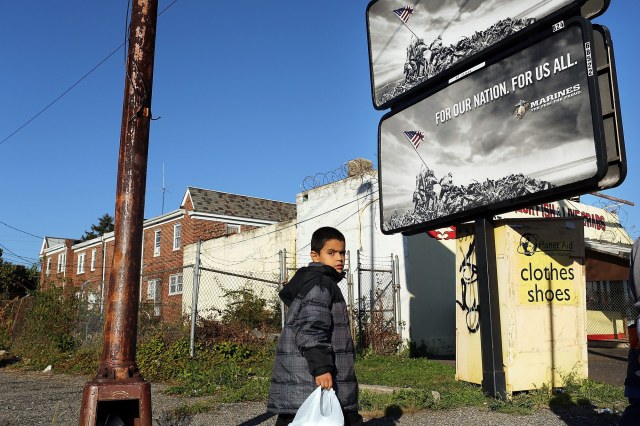Credit: Spencer Platt / Staff

America has a higher proportion of children in poverty than Russia. That’s a shocking statistic, but what it does it actually mean?
For a start, it doesn’t mean that American children are poorer than Russian children. These are relative poverty statistics, in which a poverty line is set at a given percentage of the average household national income in each nation. Because the average income in the US is significantly higher than in Russia, there are millions of Americans in poverty who are richer than millions of Russians not in poverty.
In a piece for City Journal, Kay S Hymowitz points to another problem with comparing poverty rates between countries – immigration. Different countries have different immigration patterns, taking in different numbers of immigrants from different countries of origin.
If you take millions of migrants from undeveloped parts of the world, where people are unlikely to have access to adequate levels of education and training, then that will have an impact on poverty figures in the country of destination:
“Here’s the problem in a nutshell: you can allow mass low-skilled immigration, which many on the left and the right—and probably most poverty mavens—consider humane and quintessentially American. But if you do, pursuing the equally humane goal of substantially reducing child poverty becomes a lot harder.”
The irony is that in moving from a poor country to a rich one, the migrants have greatly improved their lot.
The overall effect is certainly paradoxical, but how significant is it?
“How does immigration affect those post-1964 American child-poverty figures? Until 1980, it didn’t… The relatively small number of immigrants settling in the U.S. tended to be from affluent nations and had commensurate skills. According to the Migration Policy Institute, in 1970, immigrant children were less likely to be poor than were the children of native-born Americans.
“By 1980, chiefly because of the 1965 Immigration and Naturalization Act, the situation had reversed: immigrant kids were now poorer than native-born ones… As of 1990, immigrant kids had poverty rates 50 percent higher than their native counterparts.”
Progressives are famously fond of the ‘Scandinavian model’ – pointing to low levels of poverty in countries like Sweden. What they were less likely to point out is that, until quite recently, immigration levels – especially from non-European countries – were also low.
From the 1990s onward, that has changed:
“Sweden’s percentage of foreign-born has swelled to 17 percent—higher than the approximately 13 percent in the United States.”
Despite a still generous welfare state, Sweden is now struggling to fight poverty:
“In the U.S., immigrants are still more likely to be employed than are the native-born. In Sweden, the opposite holds. More than 26 percent of Swedish newcomers have remained unemployed long-term (for more than a year). Immigrants tend to be poorer than natives and more likely to fall back into poverty if they do surmount it. In fact, Sweden has one of the highest poverty rates among immigrants relative to native-born in the European Union. Most strikingly, a majority of children living in Sweden classified as poor in 2010 were immigrants.”
Educational outcomes are also suffering:
“According to the OECD’s Programme for International Student Assessment (PISA) survey, Sweden has ‘declined over the past decade [between 2005 and 2015] from around average to significantly below average . . . . No other country taking part in PISA has seen a steeper fall.’ The Swedish Education Agency reports that immigrant kids were responsible for 85 percent of a decline in school performance.”
However, it must be stressed that immigration is not a uniform phenomenon. Its impact is as diverse as the different places and societies from which immigrants come from. For instance, there’s good evidence that the so-called ‘London effect’ – the higher performance of London schools relative to those in the rest of the UK – is attributable to the drive and ambition of pupils from the city’s immigrant communities.
If there’s a simple lesson to draw from all of this, it’s that there are no simple lessons. How’s that for a paradox?










Join the discussion
Join like minded readers that support our journalism by becoming a paid subscriber
To join the discussion in the comments, become a paid subscriber.
Join like minded readers that support our journalism, read unlimited articles and enjoy other subscriber-only benefits.
Subscribe